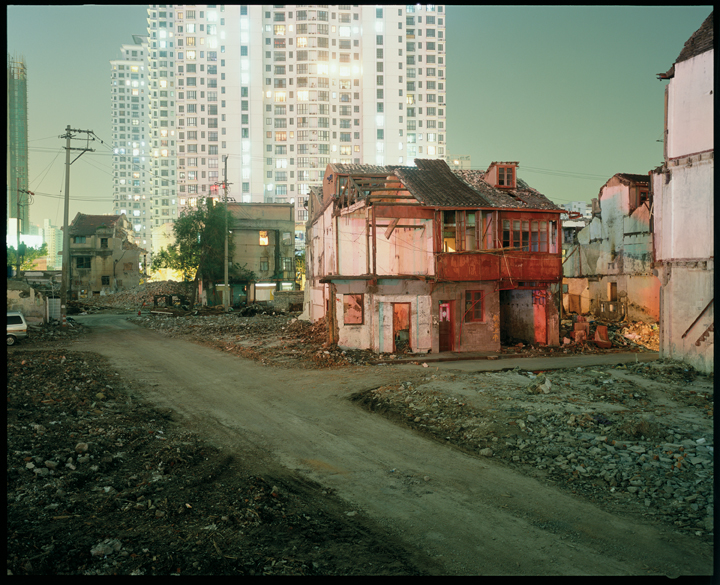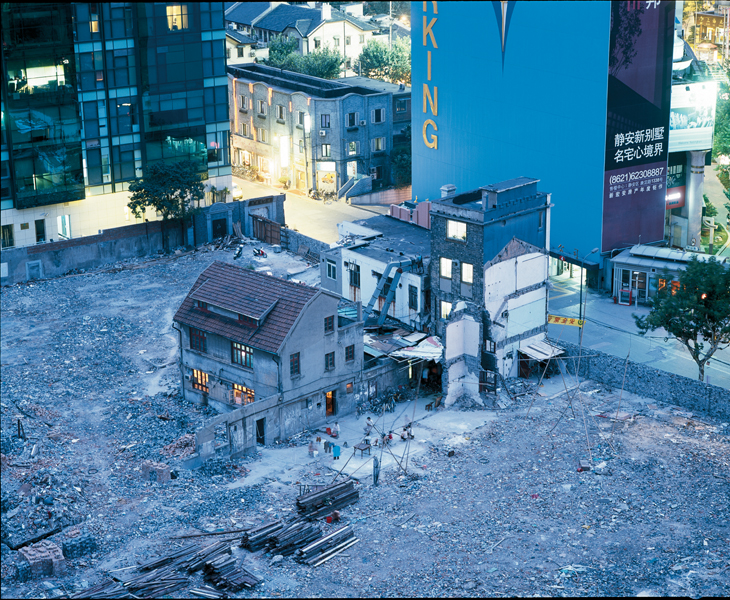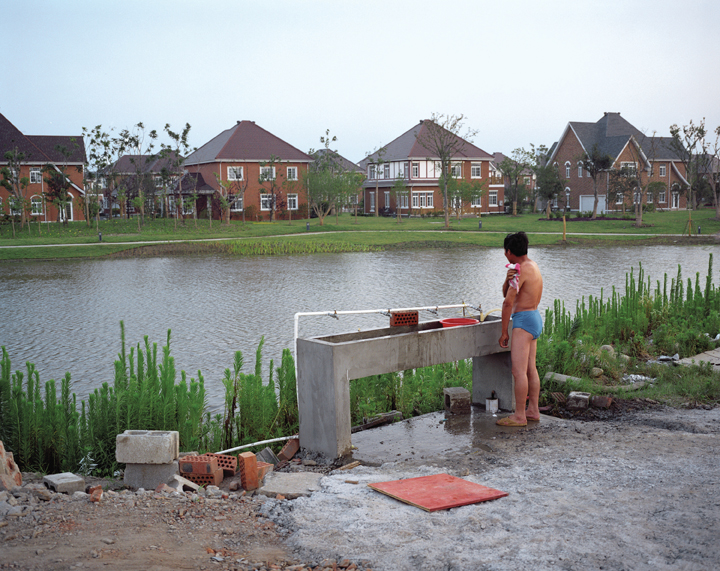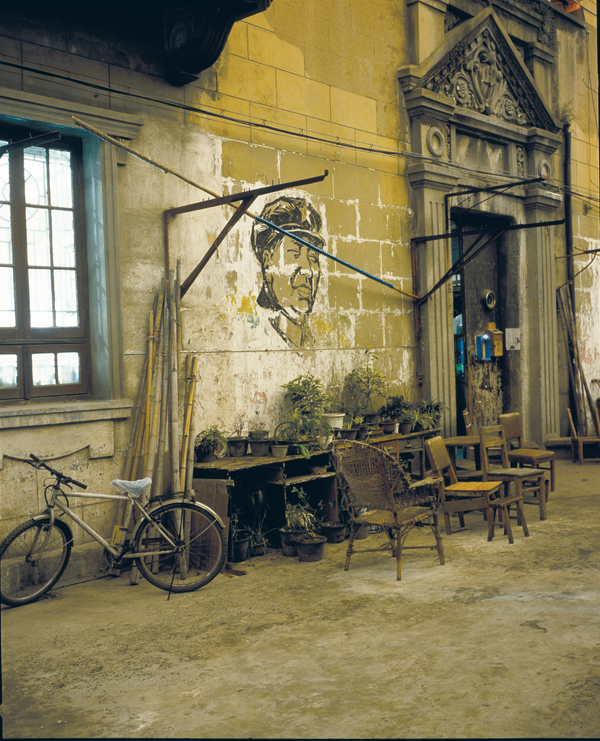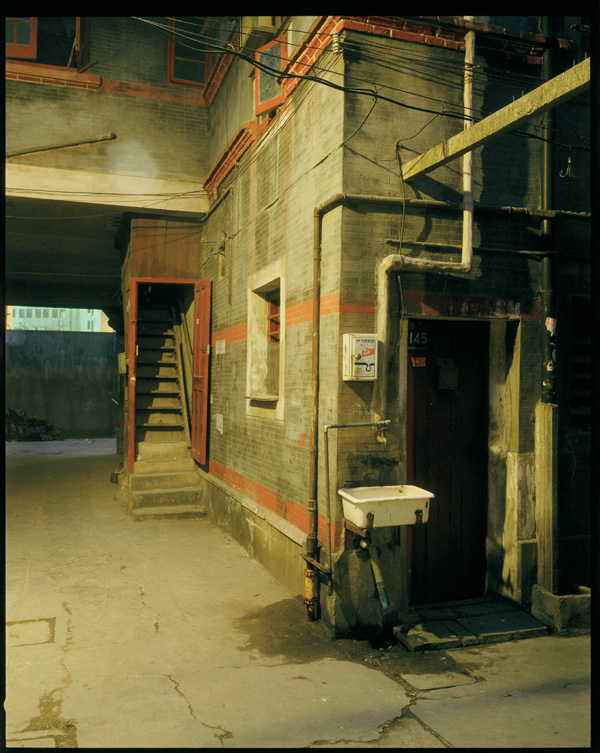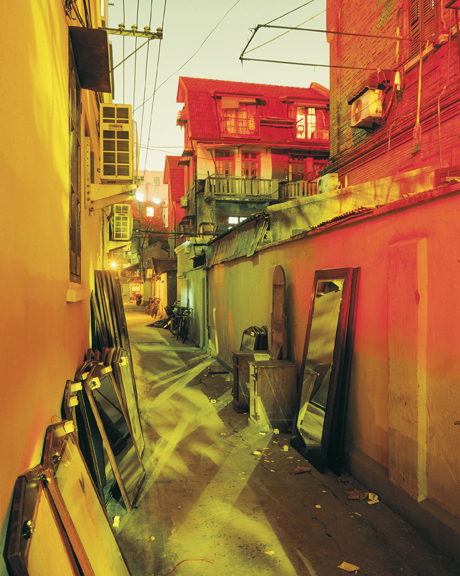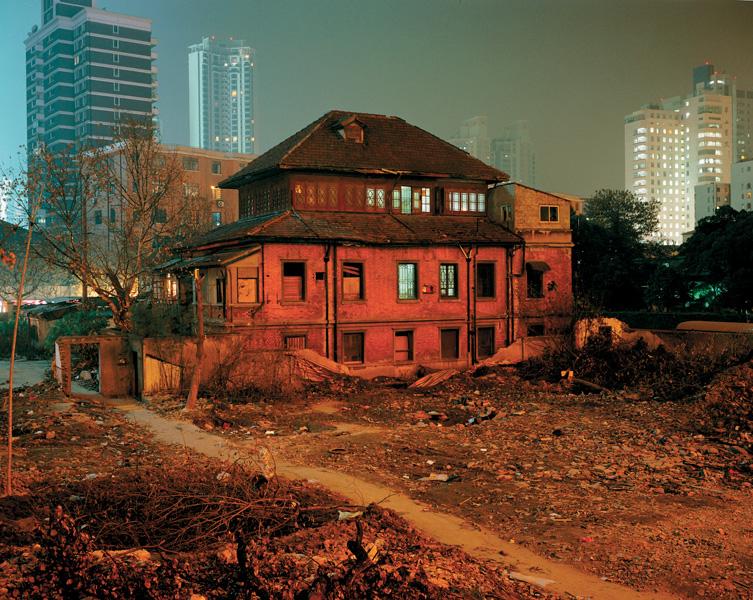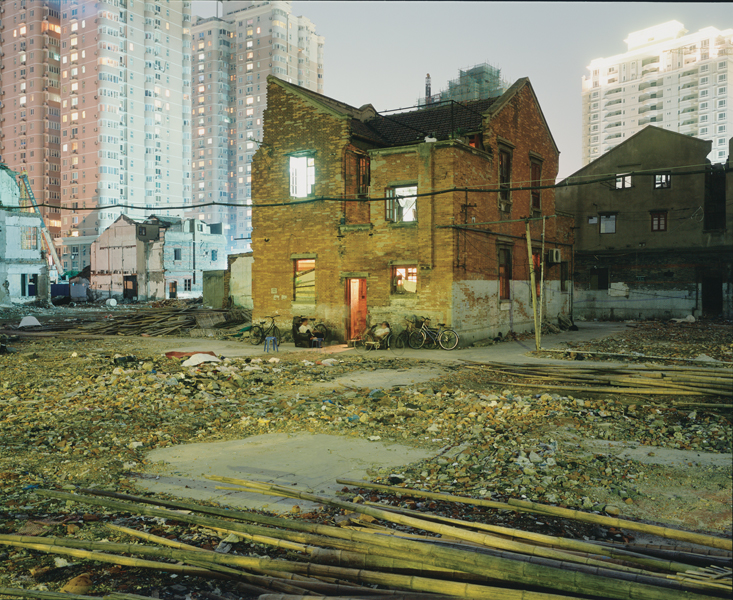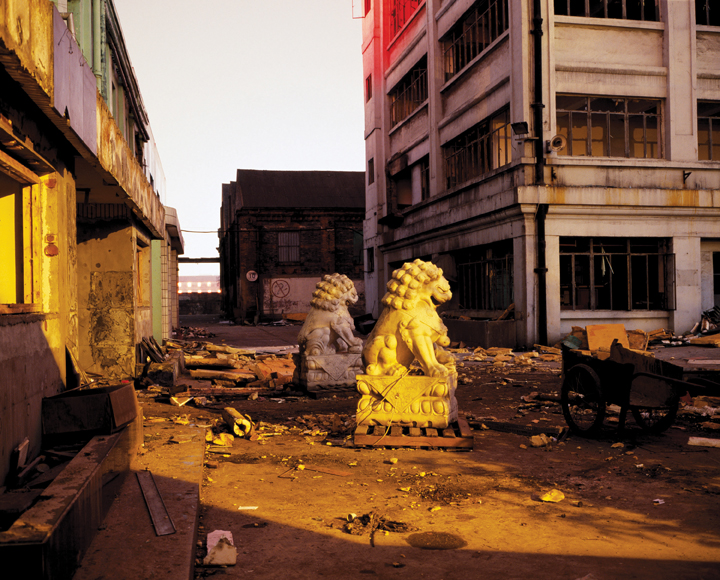by Amish Morrell
Just as these images capture Shanghai in the twilight of the twentieth century, they are taken in the dusk of early evening, or just before dawn…This temporal staging evokes the threshold between dream and awakening.
Greg Girard’s recent monograph Phantom Shanghai describes the urban vestiges of communist-era Shanghai as they are swept away in the city’s recent wave of economic development. In his images, dilapidated nineteenth-century buildings, partitioned into multiple apartments to house workers in the twentieth century, stand alone in the twenty-first century against an encroaching tide of steel and glass high-rises. Inside, makeshift mailboxes line a stairwell for addresses that will soon no longer exist. These images capture the ruins of twentieth-century Shanghai, being hastily cleared away to make room for a new version of modernity. In doing so, they engage a familiar challenge of photography: how to represent the movement of time.
The problem for many theorists, including the French philosopher Gilles Deleuze, is that time can be seen only as an indirect image. Empirical descriptions of time do not allow us to see time itself unfold, raising the problem of how to give it visual expression.1 The camera freezes movement, which can be made visible only through the juxtaposition of visual elements. In the case of film, the sequential display of still images produces an illusion of movement. In photography, time can be made visible through the juxtaposition of “before” and “after” photographs.2 In Girard’s photographs, this can be seen within the image itself, not simply through the presence of the occasional blurred figure, but through the juxtaposition of the old Shanghai in accelerated ruin and the new Shanghai in accelerated development.
Just as these images capture Shanghai in the twilight of the twentieth century, they are taken in the dusk of early evening, or just before dawn. There is none of the full brightness of the sun to fix the time of day. This temporal staging evokes the threshold between dream and awakening, a metaphor employed by the German cultural critic Walter Benjamin as a means to understand the emergence of modernity in Europe and its effects on consciousness. Benjamin examined marginal figures of the late nineteenth century, such as prostitutes, flâneurs, and junk collectors – markers of transition who revealed simultaneously the logic of the present and how the past resists an emergent present.3 The figures mark a transition between two worlds, embodying, out of necessity, conflicting value systems, each making the other visible. There is a long precedent for photography that describes such a threshold of consciousness; Eugène Atget had photographed the empty streets of Paris a century earlier. As in Atget’s photographs, Girard’s have few, if any, people, and his images also have the ethereal light of the early morning.
In his 1931 essay A Small History of Photography, Benjamin describes Atget’s photographs of handcarts lined up in the gardens, a long row of boot lasts, and building façades – images without human presence. Of these images, Benjamin writes, “…the city in these pictures looks cleared out, like a lodging that has not yet found a new tenant. It is in these achievements that surrealist photography sets the scene for a salutary estrangement between man [sic] and his surroundings.”4 Benjamin describes Atget’s photographs as being without aura (for him, this is part of what makes them surrealist). He writes, “They pump the aura out of reality like a sinking ship.” They can be de-familiarized, taken from the unique place and time that they inhabit. Girard’s images, on the other hand, are filled with aura; they are uniquely of a moment that passes as quickly as it has been grasped.
At the time these images were made, the places that they depict, unlike many other ruins, were still inhabited. One image is titled to indicate that an apartment building has been condemned for demolition; the door is open and someone is at the security desk. In another image, a bicycle stands in an alley, loaded with cardboard that has been collected. In others, a kitchen light has been left on. Phantom Shanghai captures this last moment before the building and its final inhabitants are gone. While there are few human subjects in these images, aside from a couple eating dinner in a tiny apartment or blurred figures by a doorway, there are many traces of human presence. These make it clear that people still live there: the floors are swept, the bed is made, there are vegetables on a counter, or a TV has been left on. The figures, when present, are almost always mobile and unidentifiable, against an urban backdrop that is in a rapid process of decay and reconstruction.
The fantasy (and, increasingly, the reality) of twenty-first-century Shanghai is one of global finance and high-priced real estate. With massive improvements in transportation infrastructure and housing, Shanghai is poised to become one of the world’s most important trading hubs and economic engines, shifting from a predominantly industrial economy to one based increasingly on the provision of information and services. This future is given imaginary form, in three dimensions, at the Shanghai Urban Planning Exhibition Hall, which houses a scale model of Shanghai as it will appear, radically modernized, in 2020.5 This idealized model of the future exists in stark comparison to the conditions in which workers lived during the second half of the twentieth century. It begs the question, what will become of the narrow lane-way townhouses, shikumen archways, and courtyard gardens of twentieth-century Shanghai, and how will these places be remembered?
While Girard’s images present one particular form of remembrance, a new urban development project, Xiantiandi, in the city’s centre, provides a simulation of the old Shanghai, within the economic parameters of the new Shanghai. To create a pedestrian-only shopping and entertainment district, the city evicted its former tenants, tore down decaying colonial-era buildings, and, with the investment of foreign capital, rebuilt the neighbourhood to approximate its original appearance.6 Converted into expensive boutiques and restaurants, the narrow townhouses and inner courtyards bear none of the gritty traces of their former occupants. Displaying only a few actual traces of the past – stone archways and architectural details preserved during the reconstruction – this site becomes a novelty for foreign visitors. Echoing Walter Benjamin’s famous dictum, “Even the dead will not be safe from the enemy if he wins,” this nostalgic simulation supplements the dream of twenty-first-century Shanghai, translating its history into a form seamlessly aligned with its new economic imperatives.
Girard’s images depict neither the spectacular hopefulness of SUPEH’s model Shanghai nor the packaged nostalgia of Xiantiandi, in which both future and past are simulations designed to encourage economic investment. In his depiction of the astonishingly rapid disappearance of twentieth-century Shanghai and its replacement with twenty-first-century Shanghai, a transition is witnessed in one moment. Viewers encounter the ruins that lie between these worlds and the traces of their final inhabitants. In doing so, they may ask what will become of those who live there, and how we will remember the world that they leave behind.
1 D. N. Rodowick, Gilles Deleuze’s Time Machine (Durham and London: Duke University Press, 1997), p. 81.2 This is particularly visible in Ed Burtynsky’s photographs of Feng Jie, a city destroyed and abandoned for construction of the Three Rivers Dam, in which he shows an entire cityscape razed through the juxtaposition of photographs taken two months apart. Blake Fitzpatrick, “Disaster Topographics,” in Robert Bean (ed.), Image and Inscription: An Anthology of Contemporary Canadian Photography (Toronto: YYZ Press, 2006), pp. 54–55.
3 For Benjamin, the prostitute takes the logic of the market to the extreme by employing her body as commodity; the flâneur recognizes and indulges the pull of commodities, while resisting the demands of work; and the junk collector resists both use value and exchange value in his accumulation of objects. Rajeev Patke, “Benjamin’s Arcades Project and the Postcolonial City,” in Ryan Bishop et al. (eds.), Postcolonial Urbanism: Southeast Asian Cities and Global Processes (New York and London: Routledge, 2003), p. 299.
4 Walter Benjamin, “A Small History of Photography,” in One Way Street (London: New Left Books, 1931), p. 251.
5 This is the largest scale model of its kind in the world, taking up an entire floor of the SUPEH’s seven-storey, twenty-thousand-square-metre building. Visitors are offered binoculars and can walk on suspended ramps that allow them to look down upon the model city. See S. Krupar, “A Janitorial Junket: Sweeping the Debris of Shanghai’s Future,” Radical History Review, No. 98 (2007), 160–65.
6 W. Schaefer, “Shadow Photographs, Ruins, and Shanghai’s Projected Past,” PMLA, vol. 122, no. 1 (2007), 124.
Greg Girard is a Canadian-born photographer based in Shanghai. He has been recording the social and economic changes taking place across Asia since the early 1990s, mostly for editorial and corporate clients. His first book City of Darkness, documented the final years of the Kowloon Walled City in Hong Kong. Phantom Shanghai, his second book (Magenta Books, Toronto: 2007), is in its third edition. He is represented by Monte Clarke Gallery, in Toronto and Vancouver.
Amish Morrell teaches visual culture and the history of photography at the Institute for Communication and Culture at the University of Toronto at Mississauga. He is co-editor of Expanding the Boundaries of Transformative Learning (Palgrave 2002), and his most recent research in the area of cultural memory studies examines how contemporary artists shape conceptions of community and identity through the re-staging of historical images.

